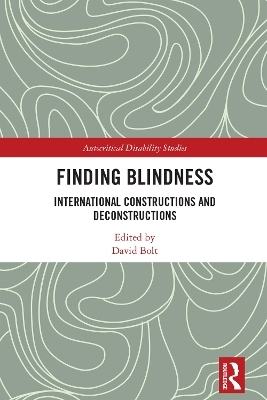
Finding Blindness
Routledge (Verlag)
978-1-032-22992-8 (ISBN)
In the terms of autocritical disability studies (i.e. an explicitly embodied development of critical disability studies), these cultural stations include key moments in education and training; the reflective pursuits of philosophy, aesthetics, and cultural theory; literary works such as autobiography, novels, short stories, drama, and poetry; visual texts ranging from photography to postage stamps; technological developments like television, computer applications, and social media; value systems defined by family and/or religion; and the social phenomenon of hate and war. Each chapter in this volume engages with two of these cultural stations; some ostensibly if not profoundly positive or indeed negative and some that contradict each other within and across chapters.
This book will be of interest to all scholars and students of disability studies, sociology, education, and health.
David Bolt (Professor) is Personal Chair in Disability Studies and Interdisciplinarity at Liverpool Hope University in the United Kingdom. He completed his PhD in 2004 at the University of Staffordshire.
Introduction: Cultural Stations of Blindness: From Ignorance to Understandings. Part 1: The Directions and Redirections of Education: Critical Spaces and Events. 1. Affective Possibilities of Everyday Encounters with Blindness. 2. From PowerPoint to Zoom: Interrogating the Gaze in Teaching at a Small South African University. 3. Blindness as a Social Construct in Cyprus: What Can We Learn from Cultural Events and Artefacts Aiming to Claim Rights, Celebrate, or Prevent Blindness?. 4. The Flag, A Rap and The Ethnographer: Looking for ‘Indianness’ within Visual Impairment. 5. Blind Student as a Bypassed Reader: Analyzing Blindness in Required Reading for Schools in Poland. Part II: The Blind Reading the Blind: Politics and Religion. 6. From World War to Social Integration and Beyond: Experiences of Blindness in Twentieth-Century Italy. 7. A State of Spiritual Derangement: Blindness in Seventh-day Adventist Theology, 1860s-1950s. 8. Faith Healing and Blindness Across Cultures: Disability, Religion, and the Scientific Milieu. 9. The Acceptance and Transcendence of Blindness: A Collaborative Autoethnography. 10. Encountering the Myth, Transforming Utopian Realities of Blindness: Counter Narrative Notes on Intersectional Interdependence and Critical Hermeneutics. 11. Crip Gazes: Eye Mutilations and the ‘Biopolitics of Debilitation’ in Lina Meruane and Nicole Kramm. Part III: Stage and the Page: Performance, Dramatics, and Literary Representation. 12. Sighted-Blindness-Consultants and the Ever-Lasting Station of Blindness. 13. Touching the Rock: Masculinity and Macular Degeneration. 14. Bringing a Brick to Market: Pedagogical Perspectives on the Discordant Interplay between Critical and Cultural Stations of Blindness. 15. To Boldly Go Where No One (Sighted) has Gone Before: Positive Portrayals of Blindness in Star Trek: TNG and H. G. Wells’s ‘The Country of the Blind’. 16. Revisiting Ruins of Blindness: A Sketched Out Silhouette.
| Erscheinungsdatum | 16.12.2022 |
|---|---|
| Reihe/Serie | Autocritical Disability Studies |
| Zusatzinfo | 2 Halftones, black and white; 2 Illustrations, black and white |
| Verlagsort | London |
| Sprache | englisch |
| Maße | 156 x 234 mm |
| Gewicht | 376 g |
| Themenwelt | Sachbuch/Ratgeber ► Gesundheit / Leben / Psychologie ► Lebenshilfe / Lebensführung |
| Studium ► Querschnittsbereiche ► Prävention / Gesundheitsförderung | |
| Sozialwissenschaften ► Soziologie | |
| ISBN-10 | 1-032-22992-6 / 1032229926 |
| ISBN-13 | 978-1-032-22992-8 / 9781032229928 |
| Zustand | Neuware |
| Informationen gemäß Produktsicherheitsverordnung (GPSR) | |
| Haben Sie eine Frage zum Produkt? |
aus dem Bereich


